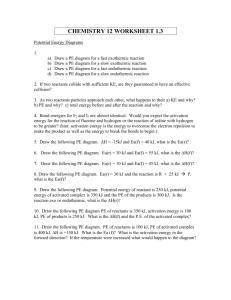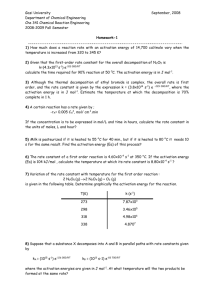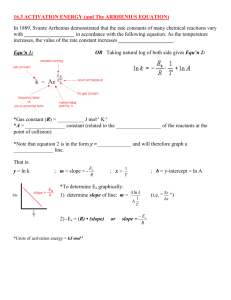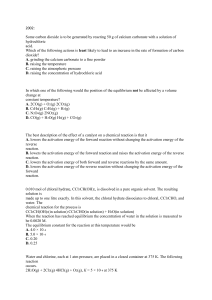Chapter 15 - CSC-year-12
advertisement
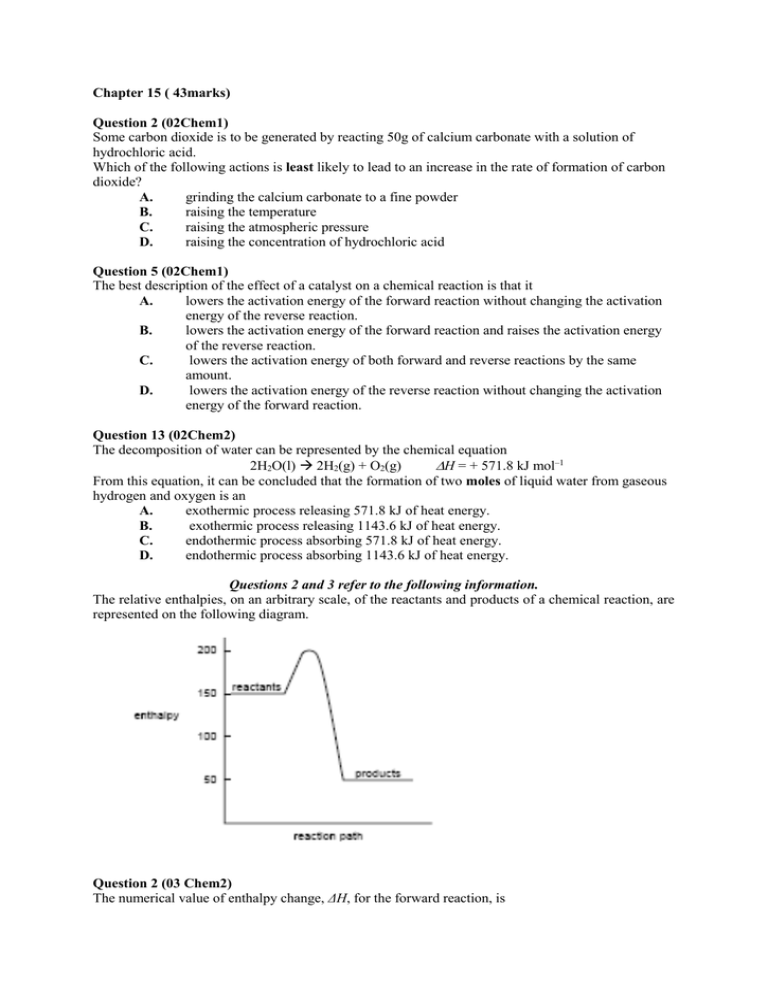
Chapter 15 ( 43marks) Question 2 (02Chem1) Some carbon dioxide is to be generated by reacting 50g of calcium carbonate with a solution of hydrochloric acid. Which of the following actions is least likely to lead to an increase in the rate of formation of carbon dioxide? A. grinding the calcium carbonate to a fine powder B. raising the temperature C. raising the atmospheric pressure D. raising the concentration of hydrochloric acid Question 5 (02Chem1) The best description of the effect of a catalyst on a chemical reaction is that it A. lowers the activation energy of the forward reaction without changing the activation energy of the reverse reaction. B. lowers the activation energy of the forward reaction and raises the activation energy of the reverse reaction. C. lowers the activation energy of both forward and reverse reactions by the same amount. D. lowers the activation energy of the reverse reaction without changing the activation energy of the forward reaction. Question 13 (02Chem2) The decomposition of water can be represented by the chemical equation 2H2O(l) 2H2(g) + O2(g) H = + 571.8 kJ mol–1 From this equation, it can be concluded that the formation of two moles of liquid water from gaseous hydrogen and oxygen is an A. exothermic process releasing 571.8 kJ of heat energy. B. exothermic process releasing 1143.6 kJ of heat energy. C. endothermic process absorbing 571.8 kJ of heat energy. D. endothermic process absorbing 1143.6 kJ of heat energy. Questions 2 and 3 refer to the following information. The relative enthalpies, on an arbitrary scale, of the reactants and products of a chemical reaction, are represented on the following diagram. Question 2 (03 Chem2) The numerical value of enthalpy change, ΔH, for the forward reaction, is A. B. C. D. +150 +50 –50 –100 Question 3 (03 Chem2) The numerical value of the activation energy for the reverse reaction is A. +150 B. +50 C. –50 D. –100 Question 4 (03 Chem2) The combustion of octane can be represented by the equation 2C8H18(g) + 25O2(g) 16CO2(g) + 18H2O(g) ΔH = –10 108 kJ mol-1 The energy produced, in kJ, by the complete oxidation of 45kg of octane is A. 2.0 × 103 B. 4.0 × 103 C. 2.0 × 106 D. 4.0 × 106 Question 18 (04 Chem1) 100 mL of 1.00 M HCl is added to a 2g piece of limestone, CaCO3. Which of the following will not increase the initial rate of this reaction? A. adding 150 mL of 1 M HCl in place of 100 mL of 1 M HCl B. adding 100 mL of 2 M HCl in place of 100 mL of 1 M HCl C. heating the 100 mL of 1 M HCl before adding it to the limestone D. adding 100 mL of 1 M HCl to powdered CaCO3 in place of the single piece of limestone Question 19 (04 Chem1) In a chemical reaction at constant temperature the addition of a catalyst A. affects the equilibrium constant. B. provides an alternative reaction pathway. C. increases the percentage yield at equilibrium. D. increases the fraction of molecules with more than a given kinetic energy. Question 20 (04 Chem1) Nitrogen (II) oxide and chlorine react according to the equation 2NO(g) + Cl2(g) → 2NOCl(g) ΔH = –38 kJ mol-1 The activation energy for the forward reaction is 62 kJ mol-1. The activation energy of the reverse reaction, in kJ mol-1, is A. –62 B. 24 C. 38 D. 100 Question 1 (04 Chem1) The main source of the element magnesium in Australia is the ore magnesite, in which magnesium is present as magnesium carbonate (MgCO3). a. Calculate the percentage by mass of magnesium in magnesium carbonate. 1 mark b. Magnesium carbonate reacts with aqueous hydrochloric acid according to the reaction MgCO3(s) + 2HCl(aq) → MgCl2(aq) + H2O(l) + CO2(g) A series of laboratory experiments was set up to study the rate of this reaction under some different conditions. The initial reaction rate was determined by measuring the rate of evolution of CO2 in a gas syringe as shown in the following diagram. Four experiments were carried out as follows. In each case, the amount of HCl present was in excess. Experiment [HCl] (M) Mass of MgCO3 (g) Initial temp in o C Final temp in o C 1 2 3 4 0.10 0.10 0.10 0.20 1.0 1.0 2.0 1.0 20 30 20 20 25 35 30 25 Initial rate of CO2 evolution in mL min-1 5 50 10 20 i. Is the reaction exothermic or endothermic? Explain how you can tell from these results. 1 mark ii. Considering experiments 1 and 2, explain why the increase in the initial temperature has raised the reaction rate. 1 mark iii. Considering experiments 1 and 3, explain why the greater mass of magnesium carbonate would have increased the reaction rate. 1 mark iv. Considering experiments 1 and 4, explain why the higher concentration of HCl would have increased the reaction rate. 1 mark v. Results from experiment 1 are plotted on the sketch graph below. On the same axes, sketch the results from experiment 3. 2 marks Questions 4, 5 and 6 refer to the following information. The oxidation of methane (natural gas) can be used to produce electricity in a gas-fired power station. Methane can also be oxidised to produce electricity in a fuel cell. The overall equation for the oxidation of methane is CH4(g) + 2O2(g) → CO2(g) + 2H2O(g) ΔH = –900 kJ mol-1 Question 4 (04 Chem2) In a gas-fired power station, the energy available from the above reaction is used to convert water in a boiler from liquid water to steam, H2O(l) → H2O(g) ΔH = + 44.0 kJ mol-1 The maximum mass of water, in grams, that could be converted from liquid water to steam by the complete oxidation of one mole of methane is A. 20.5 B. 61.8 C. 184 D. 368 Question 4 (05 Chem1) The graph below represents the energy changes over the course of a chemical reaction CO(g) + NO2(g) → CO2(g) + NO(g) a. Give the magnitude and sign of the ΔH for the forward reaction in kJ mol-1. b. Give the activation energy for the reverse reaction in kJ mol-1 1mark 1 mark c. Give two reasons explaining why the rate of this reaction increases with increasing temperature. 2 marks d. A suitable catalyst is discovered for the reaction. What would be the likely effect of the catalyst on i. the activation energy? Explain your answer. ii. the ΔH? Explain your answer. 1 + 1 = 2 marks Question 13 (05 Chem2) In which one of the following processes will the ΔH have the opposite sign to that of the other three? A. I2(s) → I2(g) B. Na+(g) + e-(g) → Na(g) C. CO2(g) → C(s) + O2(g) D. 2NaCl(l) → 2Na(l) + Cl2(g) Question 3 (05 Chem2) a. Coke, which is essentially pure carbon, is widely used as a fuel. Its complete combustion can be represented by the following equation. C(s) + O2(g) → CO2(g) ΔH = -393 kJ mol-1 However, under certain conditions, the combustion is incomplete and the following reaction also occurs. 2C(s) + O2(g) → 2CO(g) ΔH = -232 kJ mol-1 Calculate the energy, in kJ, released when 2.00 tonne (1 tonne = 106 gram) of coke is reacted with oxygen if 80% of the coke is oxidised to carbon dioxide and the remaining 20% is oxidised to carbon monoxide. 4 marks Question 3 (06 Chem1) Zinc metal reacts with 0.1 M hydrochloric acid to form hydrogen gas and zinc chloride solution. The production of hydrogen gas is more vigorous if the zinc is powdered, rather than in large pieces, because the A. activation energy of the reaction is lower. B. activation energy of the reaction is higher. C. frequency of collisions between zinc metal and hydrogen ions is higher. D. fraction of reactant particles with sufficient energy to react is higher. Question 15 (06 Chem1) Which one of the following changes would occur when a catalyst is added to an equilibrium mixture of carbon monoxide, hydrogen and methanol? A. The value of ΔH would increase. B. The amount of methanol would increase. C. The temperature of the surroundings would increase. D. The rates of both the forward and reverse reactions would increase. Question 16 (06 Chem1) Which statement about the behaviour of a catalyst in this reaction is correct? A. It decreases the activation energy of the forward reaction only. B. It increases the activation energy of the forward reaction only. C. It decreases the activation energies of both the forward and back reactions. D. It increases the activation energies of both the forward and back reactions. Question 18 (06 Chem1) Consider the following information for the reaction A + B → C. heat of reaction -120 kJ mol-1 activation energy +200 kJ mol-1 The activation energy, in kJ mol-1, for the reaction C → A + B, is A. -320 B. -80 C. +80 D. +320 Question 3 (06 Chem2) Hydrogen iodide (HI) is formed from the reaction of the elements hydrogen and iodine H2(g) + I2(g) → 2HI(g) ΔH = +52 kJ mol-1 When two moles of HI decompose A. 52 kJ of energy is released. B. 52 kJ of energy is absorbed. C. 104 kJ of energy is released. D. 104 kJ of energy is absorbed. Question 8 (07 Chem1) A chemical reaction has a ΔH of -150 kJ mol-1 and the activation energy for its reverse reaction is 350 kJ mol-1 The activation energy, in kJ mol-1, of the forward reaction is A. +500 B. +200 C. +150 D. -200 Question 14 (07 Chem1) Hydrogen iodide is produced by the reaction between hydrogen and iodine. H2(g) + I2(g) 2HI(g) Two experiments were conducted. Experiment 1: quantities of H2(g) and I2(g) were placed in a sealed vessel and the reaction allowed to proceed at constant temperature. Experiment 2: experiment 1 was repeated, but at a different temperature. The graph below shows the amount of hydrogen iodide produced over the course of experiments 1 and 2. These results show that experiment 2 was conducted at a A. lower temperature than experiment 1 and the reaction is endothermic. B. lower temperature than experiment 1 and the reaction is exothermic. C. higher temperature than experiment 1 and the reaction is endothermic. D. higher temperature than experiment 1 and the reaction is exothermic. Question 19 (07 Chem1) The reaction A + B → C; ΔH negative involves a two-step process A + B → X; ΔH positive X → C; ΔH negative Which one of the following diagrams best represents the energy changes during the course of the reaction? Question 6 (07 Chem2) Ethanol (C2H5OH) is a common fuel burnt in some lightweight, compact stoves suitable for use when hiking and camping. A diagram of such a stove is given below. a. Consider the following information. -Ethanol burns in excess air according to the following equation. C2H5OH(l) + 3O2(g) → 2CO2(g) + H2O(g) ΔH = -1364 kJ mol.1 -The cooking pot is made from aluminium and has a mass of 150g. -The specific heat capacity of aluminium is 0.900 J g-1°C-1. -The specific heat capacity of water is 4.18 J g-1°C-1. i. Calculate the minimum amount of energy, in kJ, required to heat 550g of water and the pot from 18.5°C to 100.0°C. ii. Calculate the mass, in g, of ethanol that needs to be completely burnt to provide this energy. iii. Only 35% of the energy released by the combustion of ethanol is transferred to the cooking pot and contents. Calculate the mass, in g, of ethanol that needs to be burnt in practice to heat the water and the pot from 18.5°C to 100.0°C. 2 + 2 + 1 = 5 marks b. Other camping stoves use butane (C4H10) as fuel. Given that, on complete combustion, 6.00g of butane releases the same amount of energy as 10.0g of ethanol, calculate the magnitude of ΔH, in kJ mol-1, for the reaction 2C4H10(g) + 13O2(g) → 8CO2(g) + 10H2O(g) 2 marks
